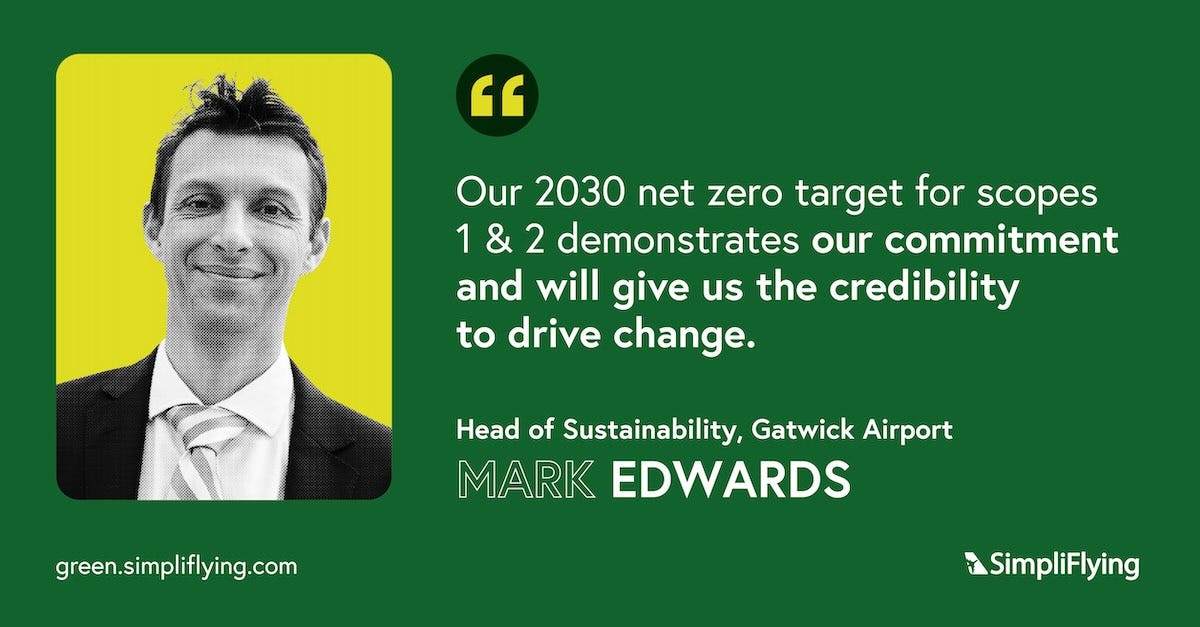In this episode of our ‘Sustainability in the Air’ podcast, Mark Edwards, Head of Sustainability at London Gatwick, speaks with SimpliFlying CEO Shashank Nigam and shares the airport’s ambitious sustainability goals, particularly its commitment to achieving net zero emissions (for Scope 1 and 2 emissions) by 2030, 20 years ahead of the UK’s national target.
[Please note: This interview was recorded in January 2024. Since then, London Gatwick has swapped diesel for HVO. Moreover, the public hearing for the Northern Runway Project began in February 2024.]
Here are the key highlights of the conversation:
London Gatwick’s approach to achieving net zero by 2030 (2:00)
Airport Carbon Accreditation and benchmarking (9:15)
Addressing Scope 3 emissions and exploring airline partnerships (13:05)
London Gatwick’s Northern Runway Project and the impact on its carbon footprint (21:10)
Infrastructure readiness for future aircraft technology (25:30)
Ensuring sustainable buildings and infrastructure (29:55)
Noise management and community engagement (31:55)
Rapid Fire! (37:04)
Keep reading for a quick overview of the episode.
Why London Gatwick’s net zero target matters for aviation sustainability
London Gatwick’s net zero goal targets Scope 1 and Scope 2 emissions. The former refers to the direct emissions from sources owned or controlled by the airport, such as the burning of fuels on-site. Scope 2 emissions are indirect emissions associated with the purchased electricity and heat consumed by the airport.
Gatwick has been addressing its Scope 2 emissions since 2014 by procuring renewable electricity through a market-based accounting system using Renewable Energy Guarantees of Origin (REGOS), which allows the airport to claim it is powered by renewable sources.
To tackle its Scope 1 emissions, Gatwick has set out a comprehensive plan which involves phasing out the use of fossil fuels such as natural gas, diesel, and petrol. The airport has over 100 boilers that currently rely on natural gas for heating, which will need to be replaced with alternative technologies. Additionally, London Gatwick operates a fleet of more than 400 vehicles, which will be gradually transitioned to electric vehicles. As an interim measure, the airport is using Hydrotreated Vegetable Oil (HVO) derived from waste products to power its diesel vehicles.
5 ways Gatwick Airport is enabling a sustainable transition
1. Sustainable infrastructure and readiness for future aircraft technology
As an airport with a long history, London Gatwick faces the challenge of retrofitting its existing buildings and infrastructure to improve sustainability performance.
To address this, Gatwick has committed to invest £250 million+ to undertake comprehensive upgrades. The retrofit program includes exploring and implementing various low-carbon heating technologies, such as heat pumps (both air-source and ground-source), electric boilers, and geothermal energy sources.
London Gatwick is also involved in discussions to adapt its infrastructure, such as providing hydrogen storage and charging facilities, to accommodate future aircraft technologies. While the plans are not yet public, Edwards emphasises that it is all part of the efforts to become “jet zero ready.”
Gatwick is also evaluating the readiness of its electrical infrastructure to support the increased electricity demand that will arise from the transition to electric vehicles and the adoption of other electrified systems.
2. Airport Carbon Accreditation and benchmarking
To demonstrate its commitment to sustainability, Gatwick has achieved Level 4+ of the Airport Carbon Accreditation (ACA) programme, which is administered by the Airports Council International (ACI).
The ACA programme provides a standardised framework for airports worldwide to measure, manage, and reduce their carbon emissions, and enables airports to benchmark their carbon performance against their peers globally.
However, Edwards points out that while the ACA focuses specifically on carbon emissions, sustainability encompasses a broader spectrum of issues that vary in importance depending on the local context of each airport. This makes direct comparisons of overall sustainability performance between airports more complex and nuanced.
3. Scope 3 emissions and airline partnerships
A significant portion of an airport’s carbon footprint, often exceeding 90%, falls under Scope 3 emissions. These emissions are indirect and beyond the direct control of the airport, with the majority stemming from airline operations, explains Edwards.
Although Gatwick has limited influence over these emissions, the airport recognises its role as a key stakeholder in the aviation ecosystem and actively seeks to collaborate with airlines to drive emission reductions.
London Gatwick is a member of Sustainable Aviation, a UK-based industry network that brings together airports, airlines, manufacturers, and other stakeholders. The network has developed a joint roadmap outlining the path to achieving net zero emissions by 2050. As part of this collaborative effort, Gatwick has ensured that its infrastructure is fully compatible with the use of sustainable aviation fuel (SAF), and is exploring ways to support the development of a suitable SAF industry.
4. Addressing other sources of Scope 1 emissions
Beyond its boilers and vehicles, London Gatwick is also addressing other sources of Scope 1 emissions, including refrigeration systems, fire training activities, and the use of de-icing fluids.
For example, refrigeration systems pose a significant challenge for Gatwick due to the potential leakage of fluorinated gases (F-gases), which are potent greenhouse gases. To mitigate this, the airport is implementing a two-fold approach: replacing F-gases with lower impact alternatives where possible, and investing in robust leak detection systems to minimise fugitive emissions.
5. Noise management and community engagement
Gatwick recognises that noise pollution is a significant concern for residents living near the airport. To manage and mitigate noise levels, a dedicated Noise and Airspace team is working on implementing a range of measures.
The airport has established a Noise Management Board, which serves as a platform for regular engagement and dialogue with community representatives, to gather feedback, share information about noise management initiatives, and collaboratively develop strategies.
London Gatwick has also put in place restrictions on the noisiest aircraft, particularly during nighttime hours. The airport incentivises airlines to deploy their quietest aircraft at night on routes serving Gatwick, encouraging the adoption of modern, noise-efficient technologies.
To further support affected communities and reduce the impact of aircraft noise, Gatwick offers a noise insulation scheme which provides funding for the installation of double glazing in eligible households.
‘Sustainability in the Air’ is the world’s leading podcast dedicated to sustainable aviation. Through in-depth conversations with top aviation leaders, we break through the clutter and provide a clear roadmap for a net-zero future.













